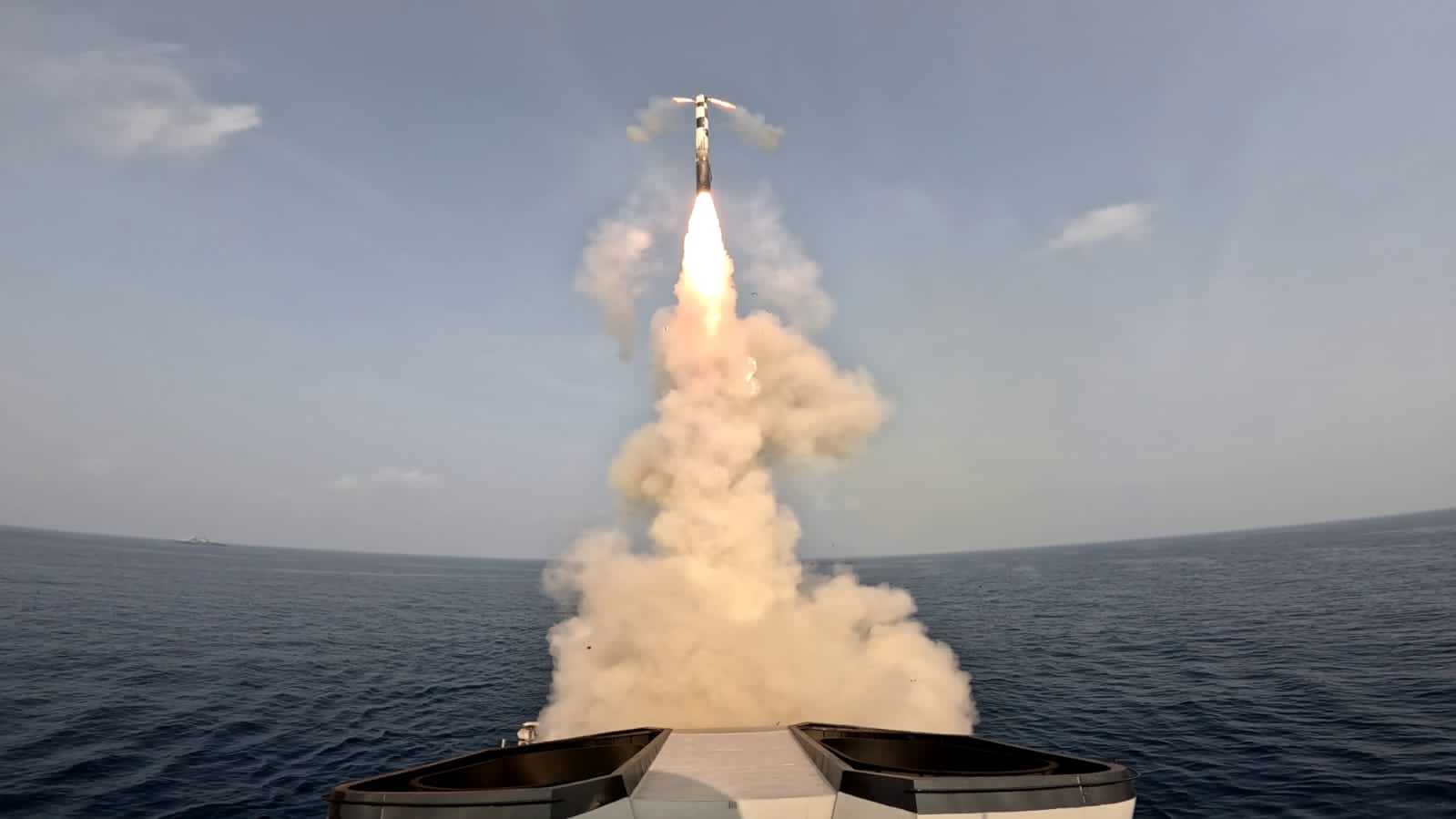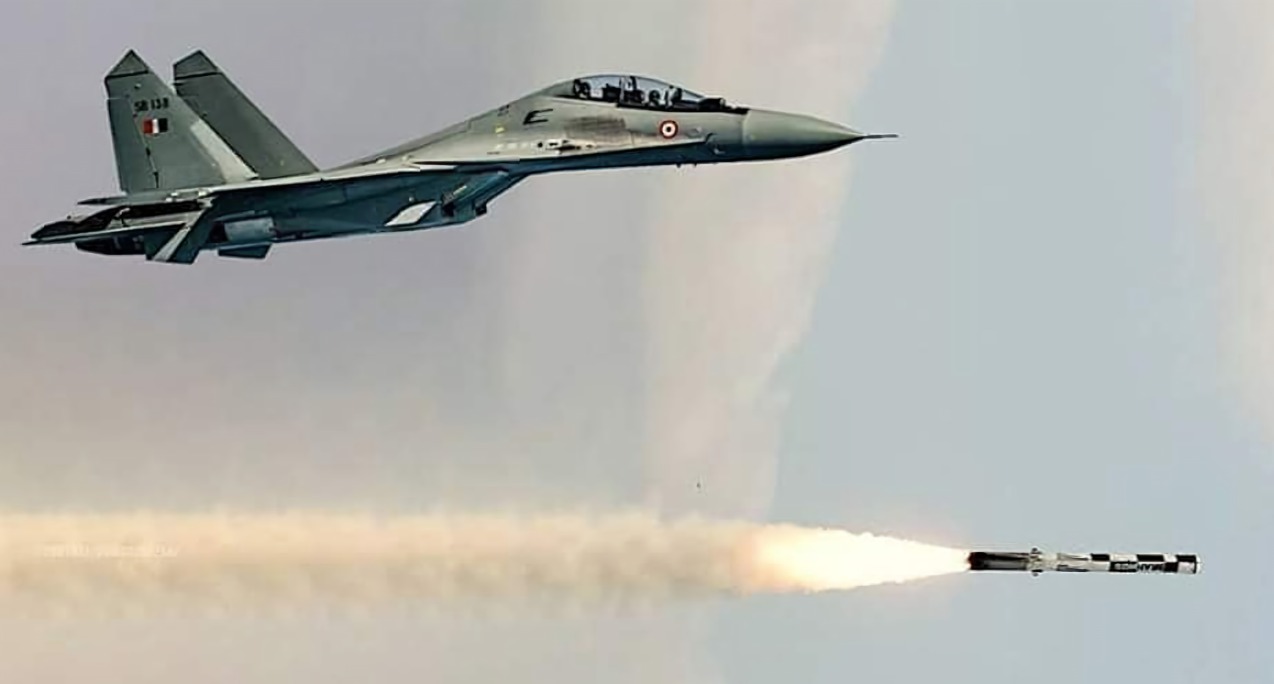One Meter CEP, Zero Reaction Time! Meet BrahMos 800 — A Missile Made In India & Feared In Pakistan:

Imagine a thunderclap that travels three times the speed of sound. Now, imagine that a thunderclap can be directed with a surgeon’s precision, striking a target 800 km away before the enemy can even register the launch.
This is not science fiction; this is the reality of the extended-range BrahMos supersonic cruise missile, India’s undisputed conventional ace.
The recent successful testing of the 800 km BrahMos variant is not merely an incremental upgrade to a successful weapon system. It is a tectonic shift in the geopolitical landscape of South Asia, an emphatic declaration of India’s indigenous technological prowess, and the establishment of a new, formidable deterrent posture.
But to truly understand the magnitude of this development, one must look back to the crucible of its combat debut: Operation Sindoor.
As Defence Minister Rajnath Singh so powerfully stated, “BrahMos is not just a missile, but it is a symbol of the country’s growing indigenous capabilities… Every inch of Pakistan is under the range of the BrahMos missile, and the whole country knows the power of it. Whatever happened during Operation Sindoor was only a trailer, my friend.”
That single, evocative phrase—”just a trailer“—captures the essence of India’s evolving military doctrine. The new 800-km BrahMos is a feature film that demands the world’s attention.
A Supersonic Legacy Forged in Fire: The BrahMos Philosophy
The name BrahMos itself is a powerful portmanteau, seamlessly blending the might of India’s Brahmaputra River and Russia’s Moskva River, symbolising a joint venture that has matured into a cornerstone of India’s strategic defense.
It represents the pinnacle of cruise missile technology: a long-range, ramjet-powered supersonic cruise missile capable of being launched from land, sea, or air, offering unparalleled multi-platform versatility.
The core tenets that make BrahMos a game-changer are simple yet devastatingly effective:
Supersonic Speed: Cruising at Mach 2.8 to Mach 3.0, the BrahMos is nearly three times the speed of sound. This incredible velocity drastically reduces the enemy’s reaction time to virtually zero. By the time a radar system detects the missile, the strike is often already complete. This high-speed kinetic energy, combined with a conventional warhead, is enough to penetrate hardened targets like bunkers and command centers.
Pinpoint Precision: With a reported Circular Error Probable (CEP) of merely one meter, the BrahMos offers unparalleled accuracy. This capability is paramount in modern warfare, allowing for surgical strikes against high-value military or terror infrastructure while minimising the risk of collateral damage. It is a weapon designed not for area bombardment, but for precise, punitive action, keeping the ‘bugsplat’ to a bare minimum.
Universal Platform Adaptability: The BrahMos system has been successfully integrated across all three branches of the Indian Armed Forces. The Army deploys it with mobile autonomous launchers; the Navy arms its frontline destroyers and frigates with vertical-launch variants; and the Air Force launches it from specially modified Sukhoi-30MKI fighter jets. This multi-platform ubiquity ensures that India can deliver a conventional strike from any domain —air, land, or sea —at any time.
This foundation of speed, precision, and versatility set the stage for its first combat trial, an event that instantly elevated the BrahMos from a strategic asset to a combat-proven legend.

Operation Sindoor: The Trailer That Changed Everything
The effectiveness of any weapon is truly measured only in combat. For the BrahMos, that test came during Operation Sindoor in May 2025. Following a brazen terrorist attack in Pahalgam, Jammu and Kashmir, which resulted in the tragic loss of lives, India’s response was swift, decisive, and relied heavily on its indigenous capabilities.
The Combat Scenario
Operation Sindoor was conceived as a non-escalatory, yet overwhelmingly punitive, precision strike deep into adversarial territory to dismantle the infrastructure of terror.
The Target: Terror hideouts and critical infrastructure used by groups like Jaish-e-Mohammed and Lashkar-e-Taiba in Pakistan and Pakistan-occupied Jammu & Kashmir (PoJK).
The Platform: Indian Air Force (IAF) Sukhoi-30MKI fighter jets, which had been seamlessly integrated with the air-launched version of the BrahMos.
The Mission: To obliterate designated targets with pinpoint accuracy, demonstrating both the intent and the capability to strike at the heart of the terror ecosystem.
The Result: ‘Pinpoint Accuracy’ and Unwavering Confidence
The missiles launched from the Su-30MKI deep inside enemy airspace performed flawlessly. Reports confirmed that the strikes were devastating, destroying terror camps and eliminating over 100 militants.
Defence Minister Rajnath Singh, in his subsequent statements, consistently highlighted the success of this operation as the ultimate validation of India’s self-reliance.
He praised the HAL’s Nashik unit for the seamless integration of the BrahMos on the Su-30MKI, stating that the operation “proved that we can design, build, and defend ourselves with our own systems.”
The key takeaway from Operation Sindoor, as emphasized by Shri Rajnath Singh, was the pinpoint accuracy of the BrahMos. The missile hit exactly where it was aimed, validating its claim of a one-meter CEP and reinforcing India’s strategic doctrine of “surgical” retaliation.
It was a clear, unambiguous message: India’s conventional deterrent is not a hypothetical threat; it is a combat-proven reality that adversaries can no longer afford to ignore.
In the words of the Defence Minister, the operation “instilled a new confidence among Indians and proved BrahMos’ effectiveness to the world,” making “victory… a habit.”
The Feature Film: The 800-km Range Revolution
If Operation Sindoor was the ‘trailer’ that showcased the BrahMos’s combat lethality, then the recently tested 800-kilometre extended-range variant is the defining moment in India’s strategic narrative.
The Quantum Leap In Strike Capability
The push to the 800-kilometre range, achieved through modifications to the missile’s ramjet engine and software, marks a massive leap from the previous ranges of 290 km and 450 km. The implications of this new strike envelope are profound:
Total Coverage of Adversarial Space: As Defence Minister Rajnath Singh declared, with the 800-km range, “Every inch of Pakistan’s territory is within the range of BrahMos missile.” This extended reach places virtually all of Pakistan’s major military headquarters, naval bases, and critical strategic installations under India’s conventional crosshairs. It is a decisive standoff capability that dramatically alters the risk calculus for any adversary contemplating aggression.
Deeper Deterrence Against the Northern Front: The enhanced range is not solely focused on the western border. The 800-km BrahMos, alongside other long-range land-attack cruise missiles, is an integral part of the proposed Integrated Rocket Force (IRF).
This system provides India with the capability to hold adversarial assets at greater distances along the challenging northern and eastern frontiers, ensuring deterrence without the immediate threat of nuclear escalation. No wonder China, too, is worried.
Enhanced Sea Control: For the Indian Navy, the ability to launch an 800-km supersonic anti-ship/land-attack missile from its frontline warships significantly enhances its power projection capabilities across the Indian Ocean Region (IOR). It allows naval assets to secure vital sea lanes and neutralize threats far beyond the horizon, bolstering India’s maritime security framework.

The Technological Edge
The successful development and testing of the 800-km BrahMos is a powerful testament to the triumph of ‘Aatmanirbharta’ (self-reliance) in defense manufacturing.
In a world where supply chain disruptions are weaponized, India’s ability to indigenously develop and upgrade such a high-technology system offers an unmatched strategic advantage.
The new Lucknow manufacturing unit, which will produce approximately 100 missiles annually, further cements India’s position as a major defense manufacturer, capable of not only meeting its own needs but also supporting its allies.
The Defence Minister’s pride in this achievement is palpable, viewing the BrahMos project as a symbol of the country’s “growing confidence and growing strength.”
The fact that the BrahMos team recently secured export contracts worth $4,000 crore (following the landmark deal with the Philippines) underscores its global appeal as a premium precision weapon.
The BrahMos in India’s Evolving Military Doctrine
The BrahMos is not just a missile; it is a central pillar of India’s contemporary military doctrine, shaping its conventional deterrence posture.
- The Conventional Punch
The BrahMos provides India with a powerful and credible conventional punitive strike option. Unlike ballistic missiles, cruise missiles like BrahMos are highly maneuverable, flying at low altitudes (sea-skimming, as low as 3 to 10 meters) with supersonic speed, making interception exceptionally difficult.
Its precision allows India to respond to threats—such as cross-border terrorism—with focused, high-impact strikes that avoid the large-scale escalation associated with heavier ordnance. The political and military utility of having a weapon that can deliver a “surgical” outcome in a strategic domain cannot be overstated.
- A Pillar of the Integrated Rocket Force (IRF)
The planned Integrated Rocket Force is intended to consolidate India’s non-nuclear missile assets into a cohesive conventional strike force. The land variant of the 800-km BrahMos, along with the Pralay ballistic missiles and long-range land-attack cruise missiles (derivatives of Nirbhay), will form the backbone of this force.
This is a clear move to address the conventional war-fighting asymmetry with rivals, allowing India to engage tactically along contested borders without crossing the nuclear threshold. The BrahMos’s adaptability to ground and air launch platforms makes it the essential multi-role weapon for this future force structure.
- A Statement of Technological Sovereignty
Rajnath Singh’s recurring theme is that the BrahMos is a “symbol of the country’s growing indigenous capabilities.” This is a profound statement. It signifies India’s transition from an importer of defense hardware to a confident, self-reliant global exporter.
This achievement instills national confidence and, perhaps more importantly, ensures that India’s strategic autonomy is never compromised by the whims of foreign suppliers or the disruption of spare parts—a threat the Minister specifically highlighted.

Conclusion: The Horizon oF Unprecedented Power
The BrahMos supersonic cruise missile, with its now extended 800 km reach and its combat baptism in Operation Sindoor, has cemented its place as the ultimate modern conventional weapon in India’s arsenal.
The strategic message is crystal clear: India possesses the will, the technology, and the capability to respond decisively to any threat. The BrahMos offers an unmatched combination of speed, precision, and range that drastically compresses the decision-making cycle of any adversary.
As the old military adage goes, “The best defense is a good offense.” The BrahMos is a technological marvel that provides strategic depth, tactical flexibility, and conventional deterrence, which few nations in the world can match.
Rajnath Singh’s warning rings with the power of unassailable fact: Operation Sindoor was indeed “just a trailer.“
The main feature, a fully weaponized BrahMos system with an 800 km range, mass-produced and integrated across all armed forces, is now rolling out. This supersonic stride is not just an Indian victory; it is a global marker of where the future of precision conventional warfare truly lies.
For India and its allies, it is a symbol of reassurance; for its adversaries, it is a new, inescapable calculus of power. The era of the Supersonic Stride has arrived, and it promises to redefine the strategic equations of the 21st century.
- Questions and Answers
- Opinion
- Motivational and Inspiring Story
- Technology
- Live and Let live
- Focus
- Geopolitics
- Military-Arms/Equipment
- Sécurité
- Economy
- Beasts of Nations
- Machine Tools-The “Mother Industry”
- Art
- Causes
- Crafts
- Dance
- Drinks
- Film/Movie
- Fitness
- Food
- Jeux
- Gardening
- Health
- Domicile
- Literature
- Music
- Networking
- Autre
- Party
- Religion
- Shopping
- Sports
- Theater
- Health and Wellness
- News
- Culture

